Water heating: what kind of it to choose and correctly mount
Heating rooms with hot water flowing through pipes, radiators, convectors or coils is still considered one of the most efficient. Unlike steam analog, water heating gives a slightly lower heat transfer, but is very popular due to a number of advantages.
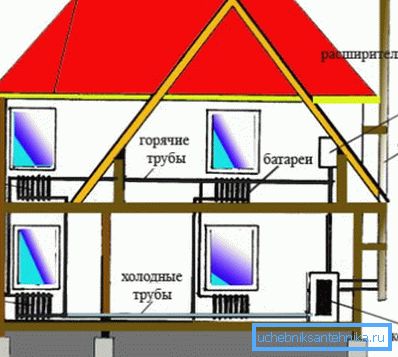
Principle of operation
- The water heating circuit is usually closed and consists of a heat generator, a network of pipes and radiators.
- Water is heated in the boiler, then flows through the pipeline into the battery.
- The heated radiators give off heat to the room, and the cooled liquid returns to the boiler for reheating.
Types of circulation
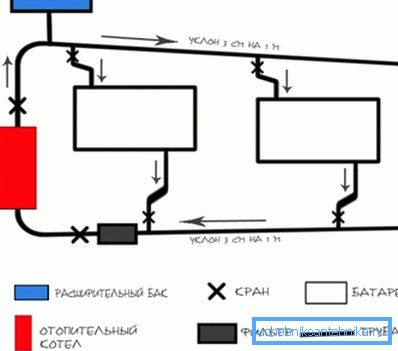
At the moment, three principles of stream creation are actively used. They are selected on the basis of individual circumstances.
Natural (gravitational) circulation
The main role in this case is played by the laws of physics, where the warmer fluid rises up, and the cooled down tends to go down. This process is the most economical because it does not require additional installation of the pump running on the mains.
Some features can be regarded as disadvantages.
- A large number of pipes with a considerable diameter for good maneuverability will be required.
- Modern batteries with a small section are undesirable; simple cast-iron radiators of old-style heating are well suited.
- The instruction obliges to observe a slope of not less than 2? To provoke a qualitative flow.
Forced movement of the coolant
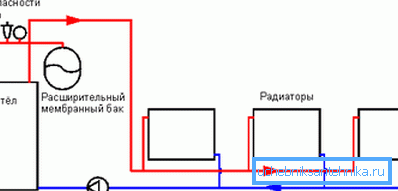
If you decide to install this type of system, please note that a circulation pump will be attached to the equipment.
The kit also contains thermostats, a pressure gauge, forcing the electric-water heating now to work in automatic mode.
- Water through the pipes drives the pump connected to the mains.
- Since the liquid increases in volume when heated, its surplus flows into the expansion tank.
Note! When using clean water, the expansion tank is kept closed or ajar. It prevents the evaporation of moisture. If a solution of water glycols is used, the tank must be tightly closed.
- To adjust the pressure in the system, you will need a pressure gauge.
- Thermostats will monitor the temperature and fix it automatically.
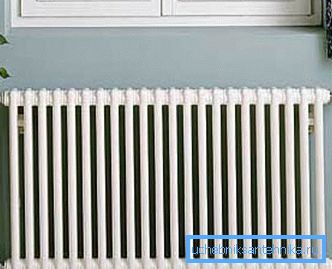
For those who appreciate convenience in everything, this type is most acceptable.
The significant drawback (extra charge for electricity) outweighs the advantages.
- The heat carrier is required much less, therefore, the consumption is minimal.
- The metric area of pipes is also reduced, and their diameter may be smaller than under the installation of natural circulation.
- Batteries fit any design, which is also important.
- Full automation will free you from servicing by yourself, devices will work for the owner.
Combined or combined type
This type is established in this form either immediately or by modifying the natural circulation.
- In parallel with the gravity system, a bypass line is installed with a circulation pump (bypass). After that, the network is able to work both in natural mode and in forced mode.
- Facilitates the installation of the presence of metal pipes and compliance with the necessary slopes.
- The bottom line is that it is advisable to begin the installation of gravitational circulation, taking into account and making out the conditions for the forced counterpart.
- At the end of the work, it is enough to install a unit with a pump, which, if necessary, can be switched on at any convenient time.
- A bypass and shut-off system allows you to switch the heating to one mode or another by opening or closing the shut-off valve.
Fuel for boilers
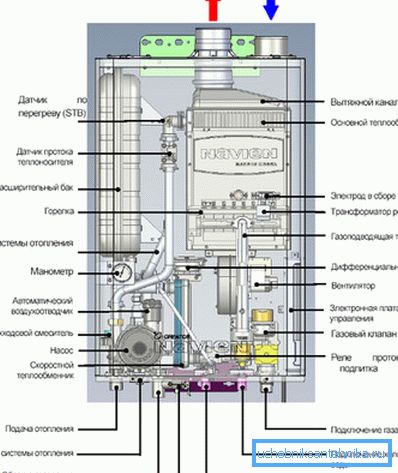
Water can be heated in different ways. Therefore, the choice of equipment will largely depend on the availability of one or another energy source.
For each region or locality there are their own, the most profitable options.
- Natural gas. The most convenient and practical type of fuel. He is also considered the most economical. But, unfortunately, this pleasure is not available everywhere. Highways to remote villages and country associations - often from the category of fiction. Bottled gas is also a way out, but it will cost more because of the delivery.
- Electricity. Electricity is better reserved for pump operation. Heat the water, and then run it through the pipes is extremely disadvantageous. Much cheaper in this case will cost electric heater for heating.
- Liquid diesel, fuel oil and the like. It works efficiently, but it should be used with a lot of safety measures. Liquids are flammable and explosive, and you will have to store containers with them in a separate room away from buildings.
- Solid fuel. More often it is firewood or coal that is literally at the side of the residents. The country is rich in forests, and coal mines are not uncommon. Often, the stores offer pellets (pellets for stoves) or briquettes from wood waste. Their price is slightly higher due to the packaging, but it is very convenient to store and use fuel.
System classification
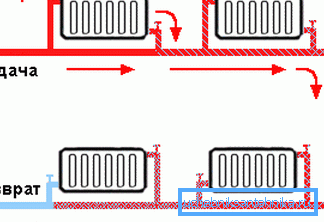
Modern heating networks are distinguished by the following features.
- According to the layout method. It can be lower, upper, vertical, horizontal or combined.
- In the direction of the coolant. There is a fair and dead-end principle.
- By hydraulics mode. Distinguish between permanent and changeable counterpart.
- By way of connecting devices. There are one-, two-, three- and four-pipe, as well as collector and combined networks.
Design differences
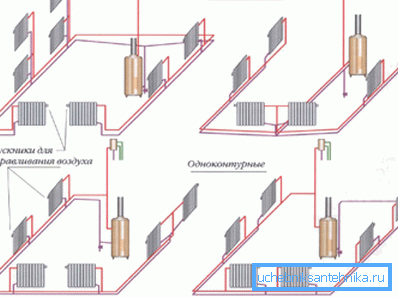
Depending on the needs of the household, it is possible to install a simple or more complex system.
- Single circuit system. The most concise option, working exclusively on heating. The intake of hot water for domestic needs (washing dishes, bathing, washing) in this case is impossible. A boiler with a single circuit with a hood, simple wiring and several radiators - that's the whole design.
- Dual circuit network it can also provide hot water for home use, not forgetting about heating. Due to the complicated construction, it will be quite expensive.
Note! Often, the owners install two single-circuit installation, where one is used only for heating and the other for hot water. The method is recognized as practical, especially for small and medium-sized houses up to 100 m2.
Conclusion
For a long time autonomous heating with hot water in a private house was considered an unattainable pleasure. Today, local water heating has become a commonplace routine available to the majority. Proper installation of equipment will provide long-awaited warmth at any time.
Pay attention to the video, here you will find answers to your questions.